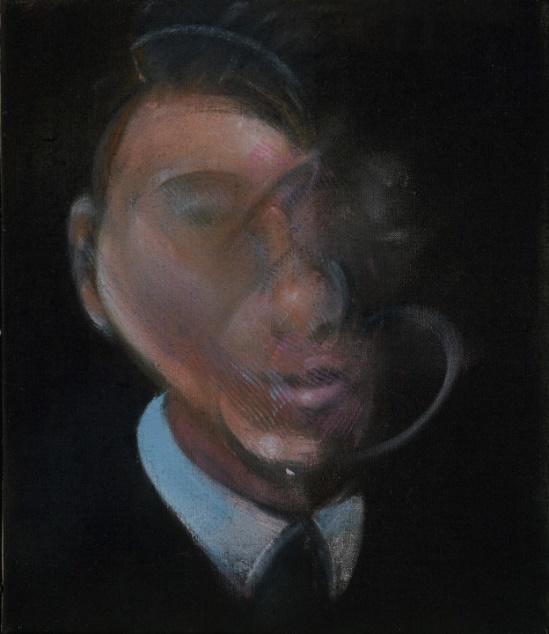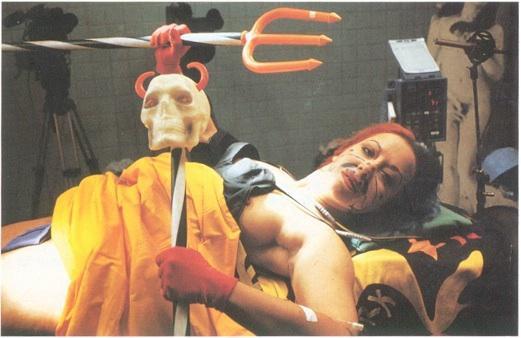Artists often rely on their own feelings and impressions while depicting the objects of the external world. The artists’ specific vision explains the particular features of the works’ styles and themes. However, much attention should be paid to the way according to which artists choose to portray themselves or to discuss the concept of self-identity in their works.
From this point, the works by the British painter Francis Bacon and French artist Saint Orlan can be considered as the most shocking and provocative examples of the artists’ discussion of their identity. Thus, to discuss the artists’ approaches to depicting themselves in detail, it is necessary to analyze Francis Bacon’s Study for Self-Portrait (1980) and Saint Orlan’s series of operation performances known as The Reincarnation of Saint Orlan (the 1990s).
Although Francis Bacon and Saint Orlan use very different techniques and means to create pieces of art, both the artists focus on rethinking the idea of self and identity, and the artists’ works catch the audience’s attention, evoke people’s strong negative emotions, and make them ask problematic questions about the individual and social development.
Francis Bacon’s Study for Self-Portrait (1980) is discussed as the example of the Existentialist painting which is characterized by the focus on personal thoughts and emotions and by the attempts to represent the feelings with the help of the figurative painting.
Thus, Bacon (1909-1992) is the British painter who is often discussed as representing the features of the Existentialist philosophy in his works, but it is important to note that the artist’s style is characterized by the use of specific techniques which make Bacon’s style rather unique (Chilvers 34). Study for Self-Portrait (1980) is painted with the oil on canvas, and the work’s size is 14 3/4 x 12 1/2 in.
Focusing on the formal elements of the painting, it is important to note that the artist’s face is portrayed disproportionally, and with the help of curved lines. The artist also refers to the contrast of dark and light colors while distinguishing between the background and the male’s face (“Study for Self-Portrait 1980”).
As a result, the audience can focus on the mysterious meaning of the face, which is depicted rather disproportionally. The viewers can feel a kind of horror while noting that only the left side of the face can be recognized. The contrast of deep dark tones and light colors works to intensify the psychological effect of the painting.

If Bacon chooses to represent himself with the help of painting, Orlan’s approach to discussing the problem of identity is more complex because the artist refers to the opportunities of performance and multimedia while creating the piece of art. The Reincarnation of Saint Orlan (the 1990s) is the series of the operation performances in which Orlan played the main role while proposing her body as the field for experimenting in the sphere of plastic surgery while relating it to the idea of female identity and the issue of beauty standards.
Focusing on the personality of Saint Orlan, it is significant to note that the woman is a French artist born in 1947, who is famous for her provocative approach to artistic performance (Nayar 158-159). That is why The Reincarnation of Saint Orlan is the series of performances which include the directed operations performed by the professional surgeons dressed in provocative costumes made by the famous world designers.
Orlan played the main role in the performances during which the surgeons made the plastic surgery operations, the artist fixed provocative postures, and the operations were accompanied with the help of dancers and different actors. All the parts of the operations were documented in the form of video and photographs to accentuate the problem of the beauty standards and female identity in the modern society (“The Reincarnation of Saint Orlan”).

In spite of the fact that Bacon and Orlan use different means and approaches to emphasize their vision of the problem of self and identity, the artists’ messages and tools to accentuate them can be compared because both the artists are inclined to manipulate the people’s reactions of shock and disgust. In his self-portrait, Bacon represents his face in isolation from the other body to accentuate the idea of loneliness typical for the Existentialist art.
The discussed work is only one example from the series of the author’s self-portraits, which are made in dark colors to be associated with the sign of death. Bacon depicts his face with the help of broken and curved lines in order to emphasize its oddity.
Thus, the discussed portrait accentuates the artist’s hatred in relation to his physical appearance and supports the idea of psychological isolation while discussing the problem of identity (Sylvester 111-112). While looking at Bacon’s self-portrait, the audience can focus on the feelings of pressure and horror because of the impossibility to accept the depth of the artist’s isolation and sufferings represented with the help of distortion.
In her The Reincarnation of Saint Orlan, Saint Orlan also pays attention to the significant effect of distortion on the audience’s understanding of the problem. The focus on broken lines, disproportion, and distortion found in Bacon’s work are also characteristic of Orlan’s works. However, using the tools of performances and multimedia, Orlan has more opportunities to discuss the problem of identity in detail. If Bacon focuses on his male self, Orlan develops her works around the idea of the female identity.
During the series of operations, Orlan disfigures and deforms her body with the help of plastic surgery and implants to create the ideal image of a woman who has the features of the females presented in the canonical paintings and different works of art. Thus, the series of operations demonstrate Orlan’s path to becoming the woman who embodies traditional standards of beauty reflected in the artworks of the Renaissance.
Demonstrating all the surgical procedures which change Orlan’s face, the artist discusses the concept of identity with the idea of a mask. Thus, during the centuries, the female body is discussed by men as a mask which can be changed according to the male standards of beauty (Allain and Harvie 58-59). As a result, women lose their identity, which can be replaced as any mask because of the males’ desires and visions.
The important part of Orlan’s performance is the use of costumes, different symbolic things, and the focus on provocative postures. Thus, being dressed as the devil and reflecting demonic elements in the costumes of all the participants, Orlan draws the audience’s attention to the evil character of the male intentions to change women in relation to their appearance.
Orlan’s demonic image and experienced surgery make the audience feel horror and disgust, but the next expected reaction is the attempt to understand the artist’s controversial message which is associated with the problem of the female identity and imposed beauty standards. As a result, the viewers of Orlan’s performances are not only shocked, but they also disturbed and called to discuss the issue of beauty standards more skeptically.
Changing the face and making it mutilated, Orlan states that all the standards connected with the human body are the fiction and provocation, and the problem is not in the body, but in the lost identity (Nayar 158-159). The similar idea is reflected in Bacon’s work because the artist is inclined to represent his face in the ugliest manner in order to accentuate the inner feelings and emotions as the meaning of the human ‘self.’
Francis Bacon and Saint Orlan cannot be discussed as the representatives of certain art movements because of the extreme uniqueness of their works and approaches to representing the idea with the help of art tools. Francis Bacon is usually considered as the representative of the Existentialist art, but this movement is too narrow to discuss the artist’s focus on personal reflections and the issue of identity represented in his self-portraits.
Saint Orlan is considered as a famous artist specializing in using the multimedia and organizing operation performances. Both the artists are unique in their styles, they refer to different techniques and tools to present their ideas, but the approaches of the artists are similar in relation to manipulating the audience’s feelings of horror and disgust with the help of shocking images. Moreover, both Francis Bacon and Saint Orlan discuss the complex problem of human identity in the works.
Works Cited
Allain, Paul, and Jen Harvie. The Routledge Companion to Theatre and Performance. UK: Routledge, 2013. Print.
Chilvers, Ian. The Oxford Dictionary of Art and Artists. UK: Oxford University Press, 2009. Print.
Nayar, Pramod. Virtual Worlds: Culture and Politics in the Age of Cybertechnology. UK: SAGE, 2004. Print.
Study for Self-Portrait 1980. Web.
Sylvester, David. Francis Bacon: The Human Body. USA: University of California Press, 1998. Print.
The Reincarnation of Saint Orlan. Web.